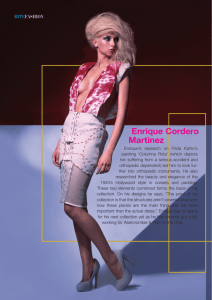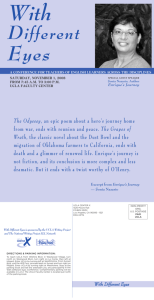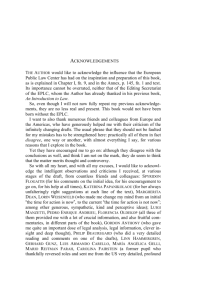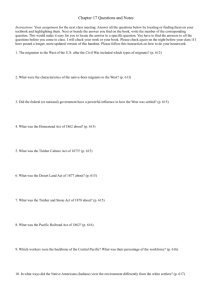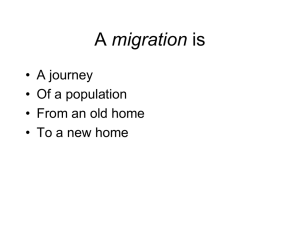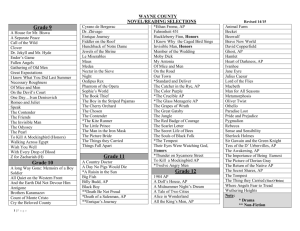Reading “Enrique's Journey”: A Study of Migration and Mexico
advertisement
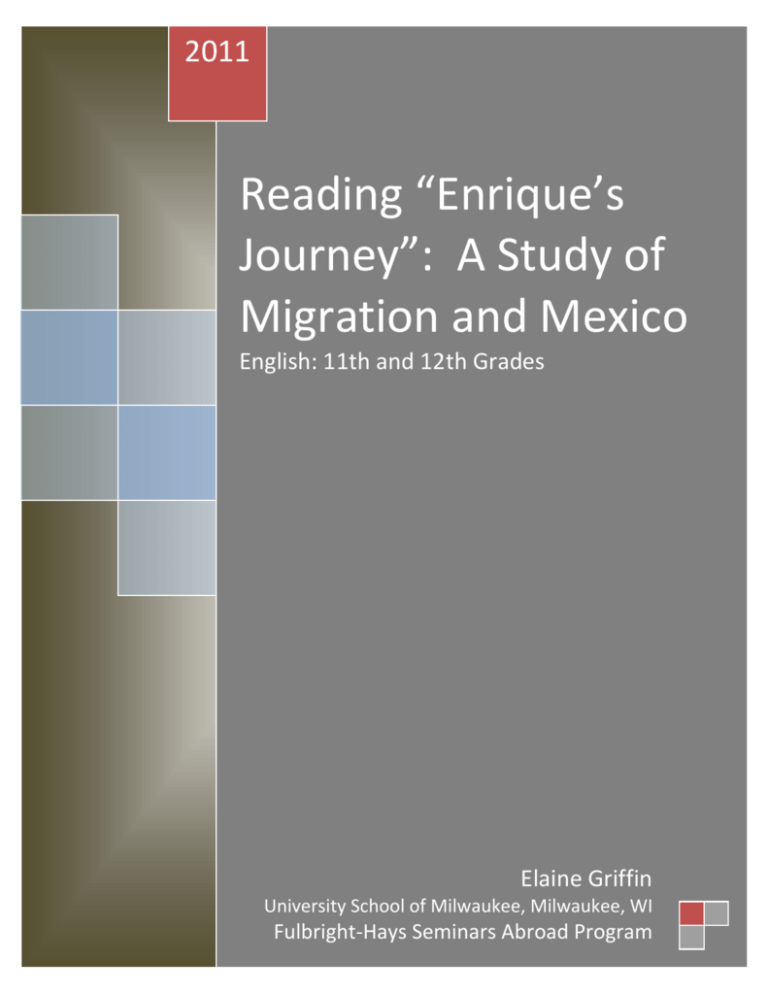
2011 Reading “Enrique’s Journey”: A Study of Migration and Mexico English: 11th and 12th Grades Elaine Griffin University School of Milwaukee, Milwaukee, WI Fulbright‐Hays Seminars Abroad Program Timeline: 2 weeks of 50‐minute classes. Unit Overview: Students will learn about the many children who migrate through Mexico to come to the United States each year on the tops of trains. They will read the non‐fiction work, Enrique’s Journey, 1 by journalist Sonia Nazario, who rode the trains herself to interview migrants along the way. They will learn about the various regions that migrants encounter as they travel from southern to northern Mexico. They will also examine images of and interviews with migrants on both sides of the Mexican and United States border. Finally, they will read about the various political views on immigration in the United States today. The culminating project of the unit is a research paper that examines Sonia Nazario’s treatment of child migration and extends or critiques her findings based on other sources. Key Questions: Why are mothers increasingly choosing to leave their children behind to travel to the United States? Why do children from countries like Honduras and Guatemala choose to make the journey through Mexico on trains? What are the physical and mental challenges of the journey? Which groups along the train route help or harm migrants? How are Mexican states different in their treatment of migrants? How are the Mexican and U.S. governments responding to child migration? How does Sonia Nazario’s account of child migration compare with other accounts? What are the political viewpoints about immigration in the current press? Standards Addressed: Wisconsin Department of Public Instruction 2 English Language Arts, Standard A, Performance Standards (Grade 12) A. 12.1 Use effective reading strategies to achieve their purposes in reading: Distinguish between fact and opinion in nonfiction texts. 1 While this text was originally published in 2006, much of its information remains relevant to the immigration debate. The research paper will allow students to look at information published since Nazario’s research. 2 This unit could be readily tailored to fit a number of other standards listed on the Department of Instruction website for Wisconsin at http://dpi.wi.gov//.html. Griffin – Reading Enrique’s Journey p. 1 A. 12.3 Read and discuss literary and nonliterary texts in order to understand the human experience: Examine, explain, and evaluate, orally and in writing, various perspectives concerning individual, community, national, and world issues reflected in literary and nonliterary texts. Identify the devices an author uses to influence readers and critique the effectiveness of their use. A. 12.4 Students will read to acquire information: Draw on and integrate information from multiple sources when acquiring knowledge and developing a position on a topic of interest. English Language Arts, Standard B, Writing Performance Standards (Grade 12) B. 12.1 Create or produce writing to communicate with different audiences for a variety of purposes: Write a coherent argument that takes a position, accurately summarizes an opposing position, refutes that position, and cites persuasive evidence. Write summaries of complex information (such as information in a lengthy text or a sequence of events), expand or reduce the summaries by adding or deleting detail, and integrate appropriately summarized information into reviews, reports, or essays, with correct citations. B. 12.2 Plan, revise, edit and publish clear and effective writing: Write essays demonstrating the capacity to communicate knowledge, opinions, and insights to an intended audience through a clear thesis and effective organization of supporting ideas. Lesson Plans: Lesson One: Introduction to Enrique’s Journey: This lesson is meant to dispel stereotypes about migrants and Mexican migration. It will also give students background into Sonia Nazario’s impetus for writing Enrique’s Journey and the complicated ethical concerns related to reporting on children in harm’s way. Pre‐Lesson Set Up: Students should read the Prologue in Enrique’s Journey for the first lesson. Objectives: Develop an understanding of migration through Mexico’s southern border. Appreciate the variety of states composing the country of Mexico. Griffin – Reading Enrique’s Journey p. 2 Identify the ethical obligations of a professional reporter. Essential Questions: What nationalities are the people who travel over Mexican borders each year? How many states must one cross to make it from Mexico’s southern border to the U.S.? Why are women in increasingly higher numbers leaving children to come to the U.S.? What are a reporter’s risks in going under cover to write a story about migration? What are the ethical concerns reporters have when they are writing about children in danger? Instructions: The purpose of this lesson is to set Enrique’s Journey in context. Thousands of children cross the Mexican border into the United States each year in search of their mothers. Give students a physical sense of the journey. Show students a map of Mexico with the states clearly marked (see Internet tools at the end of this lesson). Just as the United States is composed of various states, so too is Mexico. Point out the state of Chiapas in particular. It is where Enrique will enter Mexico and begin his travels. Many migrants are victims of kidnappings and assault in Chiapas, as gangs prey on them. Just as northern border towns, such as Juarez, are wracked by violence, so too are the southern border towns between Mexico and Guatemala. Engage students in an ethical debate about the nature of reporting on children who are subject to extreme dangers. Can a reporter give money to children she is reporting on? Does she have a duty to help children that are about to be robbed, assaulted, or kidnapped? What about giving lesser assistance, like giving lunch money or food to a hungry child? 3 Internet Tools for the Classroom: Maps of Mexico’s States http://www.mexconnect.com/articles/3437‐map‐of‐mexico‐and‐mexico‐s‐states 3 Nazario spoke at the University of Wisconsin when her book was selected for its “Big Reads” program in 2011. In her public address on October 27, 2011, in Madison, Wisconsin, Nazario said that if a reporter intervenes to change the course of the life of the individual she is writing about, she can no longer report on that individual. Nazario gave the example of not giving Enrique money when he was in desperate need of a phone card. She gave another example of how she did intervene by contacting authorities when she learned that a young woman was in danger of being assaulted. In the latter case, Nazario explained, the female’s life was in imminent danger. But Nazario is quick to point out that she then felt she could not write about this young woman because she had changed the fate of her story. You might share this information about the author with your students and ask them for their comments and reactions. Griffin – Reading Enrique’s Journey p. 3 Lesson Two: Learning about Enrique’s Story The purpose of this lesson is to examine the specific characters of Enrique and his mother, Lourdes. Students will discuss the human face of migration by looking at Enrique’s family history. Students will get a sense of the often desperate situations of families whose members decide to try to migrate north. Pre‐Lesson Set Up: Students should read chapter one in Enrique’s Journey for lesson two. Objectives: Gain a sense of the particular struggles of families who decide to migrate. Appreciate the complexity of the book’s main subjects: Enrique and Lourdes. Inform students about the role of coyotes in the smuggling process. Understand the procedures the Mexican government employs for deporting migrants. Essential Questions: What factors influenced Lourdes to journey north? How does Enrique react throughout his adolescent years to his mom’s decision? How are Enrique and his mother both victims and perpetrators in this story? What difficulties does Lourdes encounter in trying to smuggle Enrique to the U.S.? What difficulties does Enrique face on his first attempt to travel north? Instructions: Ask students to break up into small groups to discuss the following question about characterization: To what extent is Enrique a victim in this story and to what extent is he the perpetrator of his own destruction? Assign a scribe to record specific examples of Enrique suffering because of the actions of others and of Enrique making poor decisions that hurt him and those he loves. Ask students to record the page numbers of the incidents for a more focused discussion. Ask students to report their views on Enrique’s two sides to the class. At the end of the group reports, remind students about what they know about “flat” and “round” characters from their study of fictional works. Nazario presents us with a mother and son who are definitely “round” characters. To be compelling, non‐fiction books need complicated, complex characters just as great fictional texts do. Presenting Enrique in a good and bad light lends truth to his character and keeps us interested as readers. Griffin – Reading Enrique’s Journey p. 4 Continue the discussion on complex characterization by examining Lourdes, Enrique’s mother. Ask students to consider how her choices have both helped and hurt Enrique. Hold this discussion as a large group. During talk of Lourdes, be sure to address her hiring a coyote and the fact that many towns have known smugglers; students should understand that migrants have alternatives to traveling on the train (Nazario 18, 42). Lesson Three: The Dangers at the Border In this lesson, students will examine the specific kinds of risks migrants face in the southern states of Mexico. While riding a train top is certainly unsafe, corrupt police, vigilantes, and gangs are often more dangerous to migrants. Pre‐Lesson Set Up: Students should read chapters two and three in Enrique’s Journey for this lesson. Objectives: Identify the various groups that target migrants riding the train. Compare and contrast the tactics these groups use to intimidate and hurt migrants. Analyze the role of the law, such as police and government officials, in migration. Understand the physical and emotional risks migrants take during the journey. Essential Questions: How do the police behave towards Enrique and other migrants? How is Enrique physically harmed in Oaxaca? Who helps to heal Enrique after his beating? Why do migrants call traveling in Chiapas, “Facing the Beast” (Nazario 61)? How are Mexican states similar in their diversity to U.S. states? What are madrinas and what role do they play in the lives of migrants? How does the Mara Salvatrucha gang control the trains in Chiapas? Who is Olga Sánchez Martinez and how has she changed the lives of migrants? Instructions: During this lesson, it is important to emphasize that just because Enrique witnessed terrible brutality in Chiapas and Oaxaca, not everyone in those states is hostile to migrants. Just as Americans in a single state feel differently about immigration policies in the United States, so Griffin – Reading Enrique’s Journey p. 5 too do citizens of a single state in Mexico. 4 In Enrique’s experience, however, he was exposed to many of the dangerous elements of the journey in his trips through Chiapas and Oaxaca. Have students work in groups to compose a list that reflects the complicated views of the Mexican people towards immigration. Have them make a two‐sided list, one side will reflect groups who treat migrants inhumanely, while the other side will recall groups or individuals who protect and care for migrants. This is also a good time to emphasize the uniqueness of each state that Enrique visits. Just as the state of New York is different from Texas in our own country, the regions in Mexico differ greatly in terms of the people, cuisine, and landscape. Enrique’s Journey should teach them that Mexico is not a homogenous place, but rather a very heterogeneous land. I have provided four photographs taken by our trip photographer below for you to share with your students. Chiapas is one of the poorest regions in Mexico, but it is rich in culture and beauty, boasting awesome mountain regions and vibrant indigenous peoples. Visual Aids: 4 When I asked Arturo Borja Tamayo, one of the lecturers on the Fulbright trip, about regional differences towards migration, he cautioned me about making any generalizations about particular states. He captured the two sides of the debate this way several weeks later in an email: “There [are] those who think the Mexican state should protect the human rights of migrants crossing through Mexico” and “the ‘silent majority’ who, in the end, do not really care much about migrants in Mexico.” Griffin – Reading Enrique’s Journey p. 6 On the way to Chiapa de Corzo, Chiapas Highway (photo by Alejandro Montes) San Juan Chamula, Chiapas (photo by Alejandro Montes) Griffin – Reading Enrique’s Journey p. 7 Zinacantán, Chiapas (photo by Alejandro Montes) Zinacantán, Chiapas (photo by Alejandro Montes) Griffin – Reading Enrique’s Journey p. 8 Lesson Four: Help for Migrants In this lesson, students will focus on the more positive reception Enrique and his fellow travelers receive upon entering the state of Veracruz. The will examine both organized and informal acts of generosity to help migrants continue on their journeys. Pre‐Lesson Set up: Students should read chapter four in Enrique’s Journey for this lesson. Objectives: Gain a sense of why people in Veracruz express sympathy for migrants. Understand the Catholic Church’s actions in helping migrants. Inform students about clashes between the Church and police officers. Compare and contrast the treatment of migrants in Chiapas and Veracruz. Essential Questions: In what ways do people in Veracruz support Enrique and his fellow travelers? What did the priest Salamón Lemus Lemus do to help migrants in Veracruz? How did the townspeople of El Campesino El Mirador protest police violence? What kinds of help and luck does Enrique experience in this region that is very different from his experiences in Chiapas? Instructions: Give students several minutes at the beginning of class to select one passage from their reading that shows sympathetic treatment towards migrants. Hold a brief discussion to allow them to share their passages. Challenge student generalizations. For example, not all Church‐goers support migrants. Police personnel also vary in their reactions and outlook. After that discussion, I spend the remainder of the class period looking carefully at a website called The Border Film Project (see Internet tools at the end of this lesson). The project involved giving cameras to migrants, so that they could document their journeys into the United States. It also filmed American Minutemen, who had hostile feelings about the migrants entering through the border. On the Border Project website there is a twenty minute video, composed of 12 segments, that shows a series of personal perspectives from many different people. Have students take notes as you show the segments on the different views presented by migrants and by those who Griffin – Reading Enrique’s Journey p. 9 oppose migration. After students watch the film, ask them to compare and contrast what is happening on Mexico’s southern border and Mexico’s northern border. For homework ask students to get an article off of the web or a library database on activities at the border between Mexico and the United States. They should write a short summary of the article, using two or three quotations from it in their summaries. Internet Tools for the Classroom: Documentary Film and Research Sources http://www.borderfilmproject.com/en/video/ PROQUEST (a research database available at most libraries) SIRS (a research database available at most libraries) Lesson Five: Making it to the Border This lesson focuses on updating students on the activities that are currently happening at the border between Mexico and the United States. Enrique’s Journey was originally published in 2006, and while much of the experiences of Enrique are still relevant today, there have been changes in patterns of migration due to setbacks in the U.S. economy and increased border patrols. Pre‐Lesson Set‐up: Students should read chapter five for this lesson and come to class with an article about activity at the Mexico/U.S. border. They must present a summary of the article with integrated quotations. Objectives: Become familiar with current events surrounding the situation at the border. Compare and contrast the experiences of migrants at the border in 2006 (when the text was published) to experiences in 2011. Determine the essential components of an article to write an apt summary of it. Present information in a succinct but accurate way. Essential Questions: How is Enrique’s experience at the border similar or different from that of the migrants presented in your recent articles? Has violence escalated, remained stagnant, or decreased since 2006? Griffin – Reading Enrique’s Journey p. 10 How has the Mexican government become more vocal in the area of human rights for migrants since the book was published? What is the U.S. government’s current position on migration? Instructions: Begin the lesson with a “pair and share activity” in which partners report to one another about their articles and summaries. Do this activity as a warm‐up to a larger class discussion about current events surrounding border activity. Ask the class for information about what they have learned and allow students time to comment on each other’s findings. Have students clearly state their article title and publication, so that if two or more students have that article, they can all comment upon it. As students are reporting their information, write new relevant facts on the board and have students take notes to prepare for a longer research assignment at the end of the unit. For example, they should find that there are more children crossing the border now than the “estimated 48,000 children” that entered when Nazario was writing her book (Nazario 5). Students will most likely share updated information on drug gangs in Oaxaca, Chiapas, and other southern states that attack migrants, as such articles dominate the popular press. Finally, they will learn the current responses to the crisis by the Mexican government. This kind of research sharing is important, so that students realize that migration is a constantly changing issue. After students present, ask them to compare and contrast border experiences now to experiences in 2006, when Nazario wrote her book. Make sure they give specific responses based on evidence in the text and in the articles. At the end of class, show students a photo collection of border activity. This site below is particularly good for giving students a sense of the landscape of the border. They get a sense of just how vast the wall is and how difficult it would be to survive a border crossing, given the harshness of the desert. Internet Tools for the Classroom: Photo Gallery of the Border Wall and Landscape http://triggerpit.com/2011/01/04/us‐mexico‐wall‐borderlands‐wildlife‐people/ Lesson Six: The Family Reunion In this lesson students will discover that making it into the United States introduces a whole other set of problems for migrants like Enrique. They often live in substandard housing, struggle Griffin – Reading Enrique’s Journey p. 11 to find steady jobs, and suffer emotionally as they adjust to a new life far away from their homes. This is also the class in which students will be introduced to the research paper. Pre‐Lesson Set‐Up: Students should read chapter 6 for this lesson. Objectives: Become sensitized to the new set of practical problems migrants face in the United States. Analyze the psychological ramifications of reuniting families who have been separated by years of distance. Understand the difficulty of the next generation in escaping the poverty of the previous one. Introduce the research paper assignment. Essential Questions: What kinds of new emotional conflicts does Enrique have when he reconnects with his mother? What are the physical conditions under which Enrique and his mother live? How might Enrique be repeating his mother’s actions towards him when making plans about his own family? Instructions: Spend some time asking students about the living conditions and emotional conflicts Enrique and his mother experience once they are reunited in North Carolina. After initial discussion, pass out the Research Paper Assignment. Explain to students that in the previous lesson, they gathered, summarized, and analyzed articles on immigration and that they will continue to develop that skill with this paper. They will have time under teacher supervision in the library to search for articles, develop their drafts, and to ask questions about the MLS citation process. If your students are not familiar with writing research papers, set up a time for the librarian to instruct them on how to do searches with reputable databases and how to collect quotations and keep track of sources. I have one site that I use and recommend to students for keeping track of their quotations and sources (see Internet tools). Read the paper instructions aloud to students. This is a short research paper that allows students to review and critique Enrique’s Journey and add their own point of view about child immigration based on current research. While they work on this essay, they should still be Griffin – Reading Enrique’s Journey p. 12 finishing up Enrique’s Journey. Give students 1–2 weeks from presenting the assignment to completion, depending on their experience with research papers. 5 5 To give students adequate time to finish their papers after this two‐week unit, consider showing a film about the topic. If you would like to show a documentary, I recommend the film, Which Way Home. It follows kids who train hop through Mexico. I also recommend Under the Same Moon, a fictional account of a boy looking for his mother. Griffin – Reading Enrique’s Journey p. 13 Enrique’s Journey Research Paper As you read Enrique’s Journey, you will gather other sources about children crossing the Mexican border to enter the U.S. illegally. Then, you will write a five‐page paper critiquing or evaluating the book and presenting your own point of view on the topic. Strive for the appropriate tone. You’ll want to write a paper that is perceptive and convincing—that conveys your voice and your opinions—rather than a simple summary of others’ points of view. The Requirements: Gather points from Enrique’s Journey that support and challenge your ideas about the issue. Find 4–6 other sources from library databases to extend your understanding of the topic. 1. At least one source must offer an opposing view to something in the book. 2. At least one source must be visual (a photo, a political cartoon)—this source is the only one that may be from a Google search. Like your written sources, it must be integrated into your paper and commented upon. 3. At least one source must be a book review of Enrique’s Journey. You must type a works cited page and use MLA citation in your essay. Web tools can help you do this. Look at www.noodletools.com for help. The Paper: Length: The paper is to be 5–6 pages, in 12 point font. Your paper should label each section to help you organize your work. Section I. Introduction In this section, you will introduce the topic as well as the topic’s connection to Enrique’s Journey. Pull your reader in by offering a compelling statistic or by asking your reader a provocative question. Think of how Sonia Nazario presents the issue in her Prologue to capture the reader’s attention. Don’t discuss your evidence yet; stay broad. Section II. The Book’s Argument Griffin – Reading Enrique’s Journey p. 14 This is the first main part of your essay. In this section, you will examine the book’s central arguments. Don’t try to capture all of the elements of the book. You need to decide what’s most important. As you recount Nazario’s presentation of the information, discuss the strategies she uses to make her point. Consider the role of rhetoric—Ethos, Pathos, and Logos—as you analyze Nazario’s techniques. Use quotes from the text to prove your points about the techniques the author employs to show her readers her view of the issue. Don’t introduce your outside research. Here you want to look at Nazario’s treatment of the issue. Call your reader’s attention to strengths or weaknesses in the author’s approach. Be careful not to provide a summary. Look at how she persuades readers. Section III. Researched Points of View Discuss the research you uncovered. Discuss how your articles support or extend the book’s arguments. Explain opposing points of view or add additional evidence the author could have considered to bolster her story. Did you uncover any contradictory evidence that makes the book’s data ambiguous? With whom do you most agree? Section IV. Conclusion Try to be persuasive as you close your paper. You should present your ultimate judgment of Nazario’s book. Then you should present the position you take after all of your research and consideration of the topic. Section V: Works Cited Make a list of works that you cited in your paper, according to the MLA style presented on NoodleTools.com. Internet Tools: Database Resources: Proquest and SIRS. MLA resources: www.noodletools.com Griffin – Reading Enrique’s Journey p. 15 Lesson Seven and Eight: Time in the Library or Lab for Research Students need guidance when it comes to getting started with their research papers. Two class periods should be spent in the library or lab, giving students some instructions on how to do searches and collect their source data. A school’s librarian can be a helpful resource in terms of setting up an information session that provides students with a list of databases to which the school subscribes. Objectives: Provide students with the knowledge they need to perform database searches. Identify and synthesize data from a variety of articles. Show students how to integrate quoted sources into their own prose. Understand the procedures for following MLA format. Essential Questions: Questions will vary as students develop their own project angles. Instructions: The first day in lab is spent on instruction. First, I model effective searches with Proquest and SIRS, two databases that our school subscribes to, in the computer lab with my students. Be sure to model the process of narrowing searches for students. For example, using search terms like “migration” paired with “el norte” will help limit the students’ searches to items about migration through Mexico. After you spend some time showing them how to tailor their searches, be sure to give students instructions in how to collect and cite their sources. I review how to best use NoodleTools.com, a free website that allows students to organize their notecards and collect their citations online. It also guides them through the citation process by asking a number of guiding questions as they list items for the Works Cited page. I like to use the website’s instructor PowerPoint called, “Citing Sources.” The slides offer helpful advice about how students can get the most out of the site. Day two in lab is spent helping students with their searches and their use of NoodleTools.com. I find that my students need an entire period to get their questions answered and search for helpful articles. Griffin – Reading Enrique’s Journey p. 16 Lesson Nine: Enrique’s Life in the United States In this lesson students return to the classroom to continue their discussion of Enrique, with a detailed look at how his life actually is in the United States in comparison to what he imagined it might be. This chapter presents the most compelling evidence in the book about how migration hurts family unity. Students will come to see that fractured relationships can’t be repaired through monetary gifts and that there is no way to completely make up for the lost years that separate many migrants from their loved ones. Pre‐Lesson set up: Students should read chapter seven for this lesson. Objectives: Identify the reasons that reunited families continue to suffer emotionally. Examine the tenuous nature of work opportunities for migrants. Understand the cyclical nature of migrants leaving their families, following in their parents’ footsteps. Essential Questions: How does Enrique relate to his daughter in Honduras? What factors cause conflict between Enrique and Lourdes? How has Maria Isabel’s relationship with Enrique deteriorated? Why does Maria Isabel decide to leave her daughter, even after she has witnessed the pain Enrique experienced by his mother’s absence? Instructions: In this lesson, I give students a list of discussion questions and put them in groups. The worksheet questions ask a number of evaluative questions that get students thinking about how they feel about Enrique’s family situation at the end of the book. After groups discuss and record their answers have a larger discussion about the cycle we see in terms of Enrique being a stranger to his own daughter and then Maria Isabel deciding to leave their daughter behind to join Enrique. At the discussion’s end, ask students if Enrique’s life in the United States was worth the emotional costs he expended in getting that new life. After discussion, project Sonia Nazario’s website to the class. She has a brief update on Enrique and his living situation. This discussion will close the examination of Enrique. Griffin – Reading Enrique’s Journey p. 17 Internet Tools for the Classroom: Sonia Nazario’s Website http://www.enriquesjourney.com/family.html Enrique’s Journey Chapter Seven Discussion Questions 1. What motivates Enrique to stay in the United States? What things make him wish to return to Honduras? 2. What factors cause conflict between Enrique and Lourdes? How do they seek to overcome these factors? Do you think they will ever have a peaceful relationship? 3. Contrast Enrique’s life in the United States with the life he left behind. Do you think his journey was worth the life he has now in the United States? 4. Why does Maria Isabel leave her daughter behind in Honduras after promising that she would not do so until her daughter was older? How do you feel about her decision? Griffin – Reading Enrique’s Journey p. 18 Lesson Ten: Final Impressions of Immigration In this lesson students examine the immigration debate as it is outlined in the afterword and epilogue of the book. They will examine migration from three different lenses: the effect migration has on the migrant, the effect it has on the migrant’s home country, and the effect it has on the United States. In the end, students should see that one’s support or disapproval of immigration is tightly linked to one’s role in society, especially to one’s social class. Pre‐Lesson Set up: Students should read the afterward and epilogue to prepare for this lesson. Objectives: Identify the reasons that migrants benefit and suffer from immigration to the United States. Understand how home countries of migrants benefit and lose when so many of their citizens leave. Examine what is beneficial and harmful to the United States with the influx of migrants. Essential Questions: What do school officials say about migrant children and their emotional state? How do home countries benefit financially from the exodus of migrants? How do employers in the United States benefit from migrant labor? Why do some U.S. citizens view immigrants as a burden to society? How does one’s support or disapproval of immigration depend on who you are? (consider things like one’s social class, one’s role in business, etc.) Instructions: At this point students will have read some articles about immigration for their research essays and should be able to contribute more than the facts Nazario presents to inform a classroom discussion. Break the students into three categories or teams: the migrant, the home country, and the United States. Have students meet in their teams and brainstorm the pros and cons of immigration for their identity. After they have met and made a list, have them write their pros and cons on the board. Each group should have a representative present the information to the class. Now ask the class to choose the biggest winner and to identify why they make that choice. Afterwards, ask them to identify the biggest loser and again require them to defend their choice. Griffin – Reading Enrique’s Journey p. 19 This discussion will conclude a two‐week period devoted to the study of the book and to an introduction of the research paper. On the day the research paper is due, I ask students to share one piece of evidence they learned from an article and to read it to the class. Students can also comment on their essay conclusions, in which they formulated their final opinions about Enrique’s Journey and about child immigration in general. Bibliography “Border Film Project.” Border Film Project. N.p., n.d. Web. 15 Dec. 2011. <http://www.borderfilmproject.com//.>. Burton, Tony. “Map of Mexico and Mexico’s States.” Mex Connect. Mex Connect, 2 Mar. 2009. Web. 15 Dec. 2011. <http://www.mexconnect.com//‐map‐of‐mexico‐and‐mexico‐s‐states>. “DPI Standards.” Department of Public Instruction‐Wisconsin. DPI, 1 Oct. 2009. Web. 11 Nov. 2011. <http://dpi.wi.gov//.html>. Hirn, Marcus. “US Mexico Wall Borderlands: Wildlife and People.” Trigger Pit. Triggerpit.com, 4 Jan. 2011. Web. 15 Dec. 2011. <http://triggerpit.com////mexico‐wall‐borderlands‐wildlife‐people/>. Nazario, Sonia. Enrique’s Journey. New York: Random House, 2007. Print. ‐ ‐ ‐. “Enrique’s Journey.” Madison’s Big Read, 2011. Madison, Wisconsin. 27 Oct. 2011. Address. ‐ ‐ ‐. “Update of the Family.” Enrique’s Journey. N.p., Oct. 2011. Web. 15 Dec. 2011. <http://www.enriquesjourney.com/.html>. NoodleTools. NoodleTools, n.d. Web. 15 Dec. 2011. <http://noodletools.com//.php>. Tamayo, Arturo Borja. “Fulbright Teacher.” Message to the author. 29 Sept. 2011. E‐mail. Griffin – Reading Enrique’s Journey p. 20
